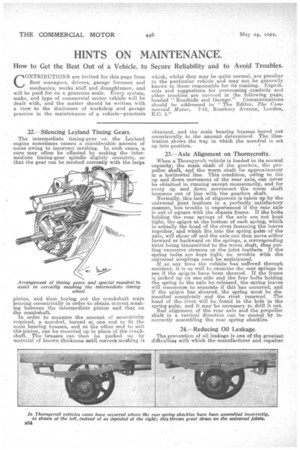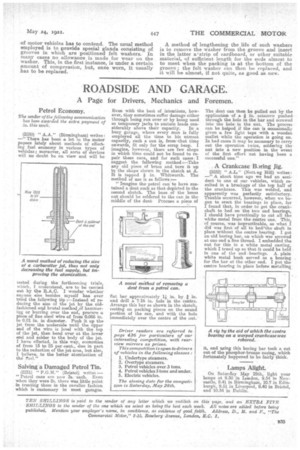HINTS ON MAINTENANCE.
Page 30

Page 31

If you've noticed an error in this article please click here to report it so we can fix it.
How to Get the Best Out of a Vehicle, to Secure Reliability and to Avoid Troubles.
CONTRIBUTIONS are invited for this page from fleet managers, drivers, garage foremen and mechanics, works staff and draughtsMen, and will be paid for on a generous scale. Every system, make, and type of commercial motor vehicle will be dealt with, and the matter should be written with a view to the disclosure of workshop and garage practice in the maintenance of a vehicle—practice's
which, whilst they may be quite normal, are peculiar to the particular vehicle and may not be generally known to those responsible for its running. Expedients and suggestions for overcoming roadside and other troubles are covered in the following page, headed "Roadside and Garage." Communications should be addressed to "The Editor, The Commercial Motor, 7-1o, Rosebery Avenue, London, E.C.
22.--Silencing Leyland Timing Gears.
The intermediate timing-gear on the Leyland engine sometimes causes a considerable amount of noise owing to incorrect meshing. In such cases a cure may often be effected by making the intermediate timing-gear spindle slightly eccentric, so that the gear can be meshed correctly with the large
pinion, and then boring out the crankshaft main bearing eccentrically in order to obtain eerreat meshing between the intermediate pinion and that on the crankshaft.
In order to measure the amount or eccentricity required, a mandrel, turned at one end to fit the main bearing brasses, and at the other end to suit the pinion, can. be mounted up in nlace of the crankshaft. The brasses can then be packed uo by material of knownthickness until correct). meshing is obtained, and the main bearing brasses bored out eceentrically_ to the amount determined. The illustration shows the way in which the mandrel is set up into position.
23.—Axle Alignment on Thomycrotts.
When a Thornycroft vehicle is loaded to its normal capacity, the main shaft of the gearbox, the propeller shaft, and the worm shaft lie approximately in a horizontal' line. This condition, owing to the up and down movement of the rear axle, can never be obtained in running except momentarily, and for every up and down movement the worm shaft becomes out of line with the gearbox shaft. Nozmally, this lack of alignment is taken up by the
joint oint leathers in a perfectly satisfactory rammer, buts trouble is experienced if the rear axle ii out of square with the chassis frame. If the bolts holding the rear springs of the axle are not kept tight, the spigot at the bottom of each spring, which is actually the head of the rivet fastening the leaves together, and which fits into the spring palm -of the axle, will shear off and the axle can then move either forward or backward on the springs, a corresponding twist being transmitted to the worm shaft, thus putting excessive stresses on the joint leathers. If the spring bolts are kept tight, no trouble with the universal couplings need be anticipated. If at any time the vehicle has suffered through accident, it is as well to examine the rear springs to see if the spigcts have been sheared. If the frame is jacked up en one side and the four bolts holding the spring to the axle be released, the spring leaves will commence to separate if this has occurred, and if the spigot has sheared, the .spring must be dismantled completely and the rivet renewed. The head of the rivet will be found in the hole in the spring palm, and it may be necessary to drill it out.
Bad alignment of the rear axle and the propeller shaft in a vertical direction can be mused by incorrectly assembling the rear spring shackles.
24.—Reducing Oil Leakage.
The prevention of oil leakage is one of the greatest difficulties with which the manufacturer and repairer• of motor vehicles has to contend. The usual method employed is to provide special glands consisting of grooves in which are positioned felt washers. In many cases no allowance is made for wear on the washer. This, in the first instance, is under a certain amount of compression, but, once worn, it usually has to be replaced.
A method of lengthening the life of such washers is to remove the washer from the groove and insert in the latter a'strio of cardboard, or other suitable material, of sufficient length for the ends almost to to meet when the packing is at the bottom of the groove; the felt washer can then be replaced, and it will be almost, if not quite, as good as new.
































